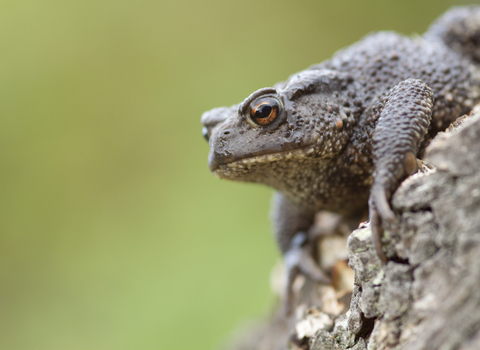Pond dipping (c) Emma Websdale
Ponds
Even small ponds can support a wealth of species and collectively, ponds play a key role in supporting freshwater wildlife. One of the most effective ways to make your garden or local green space more wildlife friendly is to add some water!
A familiar feature of many field corners, village greens and gardens, ponds are generally small in size but can range from one to twenty thousand square metres. They're not connected to each other or to other water bodies, and are only fed by rainwater or groundwater.
You don't need much space for a pond, and making one doesn't have to be expensive or labour intensive - an old sink or garden planter can be enough to attract wildlife.
The best ponds for wildlife have shallow margins with a fringe of vegetation and nearby plant cover for amphibians and insects with terrestrial life stages. If there is space, a few plants that grow both entirely submerged and others that float on the surface.
Some pond plants can be very invasive and can quickly take over, so it's important to research your plant of choice before introducing it to your new pond. Safe plants for your pond include:
Plants for deep water
- Hornwort
- Water crowfoot
- Common water starwort
- Spiked water milfoil
Plants for the shallows
- Water forget me not
- Water mint
- Brooklime
- Yellow flag iris
- Flowering rush
- Water plantain
Plants for the edges
- Meadow sweet
- Purple loosestrife
- Ladies smock
- Marsh marigold
- Rushes or sedges
Plants to avoid
Plants to avoid
- Curly waterweed (Lagarosiphon major)
- Canadian pondweed (Elodea canadensis)
- Nuttall's pondweed (Elodea nuttallii)
- Water hyacinth (Eichhornia crassipes)
- Water lettuce (Pistia stratiotes)
- Floating water primrose (Ludwigia grandiflora, Ludwigia uruguayensis and Ludwigia peploides)*
- Floating pennywort (Hydrocotyle ranunculoides)*
- Parrots feather (Myriophyllum aquaticum)*
- Australian swamp stone-crop (Crassula helmsii)*
- Water fern (Azolla filiculoides)*
* These plants have been banned for sale in the UK.
To avoid accidentally spreading non-native invasive species into the wider countryside, don't move plants or animals between ponds and always compost any plant material that’s been removed.

